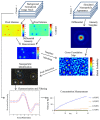Developments in Transduction, Connectivity and AI/Machine Learning for Point-of-Care Testing
- PMID: 31018573
- PMCID: PMC6515310
- DOI: 10.3390/s19081917
Developments in Transduction, Connectivity and AI/Machine Learning for Point-of-Care Testing
Abstract
We review some emerging trends in transduction, connectivity and data analytics for Point-of-Care Testing (POCT) of infectious and non-communicable diseases. The patient need for POCT is described along with developments in portable diagnostics, specifically in respect of Lab-on-chip and microfluidic systems. We describe some novel electrochemical and photonic systems and the use of mobile phones in terms of hardware components and device connectivity for POCT. Developments in data analytics that are applicable for POCT are described with an overview of data structures and recent AI/Machine learning trends. The most important methodologies of machine learning, including deep learning methods, are summarised. The potential value of trends within POCT systems for clinical diagnostics within Lower Middle Income Countries (LMICs) and the Least Developed Countries (LDCs) are highlighted.
Keywords: POCT; artificial intelligence; deep learning; microfluidics; mobile phone; photonics.
Conflict of interest statement
The authors declare no conflict of interest. This paper does not raise any ethical issues.
Figures







Similar articles
-
Recent Advances of Utilizing Artificial Intelligence in Lab on a Chip for Diagnosis and Treatment.Small. 2022 Oct;18(42):e2203169. doi: 10.1002/smll.202203169. Epub 2022 Aug 26. Small. 2022. PMID: 36026569 Review.
-
Microfluidics-Based Point-of-Care Testing (POCT) Devices in Dealing with Waves of COVID-19 Pandemic: The Emerging Solution.ACS Appl Bio Mater. 2022 May 16;5(5):2046-2068. doi: 10.1021/acsabm.1c01320. Epub 2022 Apr 27. ACS Appl Bio Mater. 2022. PMID: 35473316 Review.
-
Internet of medical things (IoMT)-integrated biosensors for point-of-care testing of infectious diseases.Biosens Bioelectron. 2021 May 1;179:113074. doi: 10.1016/j.bios.2021.113074. Epub 2021 Feb 6. Biosens Bioelectron. 2021. PMID: 33596516 Free PMC article. Review.
-
Microsystem Advances through Integration with Artificial Intelligence.Micromachines (Basel). 2023 Apr 8;14(4):826. doi: 10.3390/mi14040826. Micromachines (Basel). 2023. PMID: 37421059 Free PMC article. Review.
-
Artificial intelligence performance in testing microfluidics for point-of-care.Lab Chip. 2024 Oct 22;24(21):4998-5008. doi: 10.1039/d4lc00671b. Lab Chip. 2024. PMID: 39360887 Free PMC article.
Cited by
-
Applications of microfluidic chip technology in microvascular thrombosis research.Mikrochim Acta. 2025 May 24;192(6):371. doi: 10.1007/s00604-025-07239-1. Mikrochim Acta. 2025. PMID: 40413353 Review.
-
Validation in Zambia of a cervical screening strategy including HPV genotyping and artificial intelligence (AI)-based automated visual evaluation.Infect Agent Cancer. 2023 Oct 16;18(1):61. doi: 10.1186/s13027-023-00536-5. Infect Agent Cancer. 2023. PMID: 37845724 Free PMC article.
-
Facilitators and barriers to in vitro diagnostics implementation in resource-limited settings: A scoping review.Afr J Prim Health Care Fam Med. 2023 Feb 3;15(1):e1-e9. doi: 10.4102/phcfm.v15i1.3777. Afr J Prim Health Care Fam Med. 2023. PMID: 36861922 Free PMC article.
-
Emerging Options for the Diagnosis of Bacterial Infections and the Characterization of Antimicrobial Resistance.Int J Mol Sci. 2021 Jan 5;22(1):456. doi: 10.3390/ijms22010456. Int J Mol Sci. 2021. PMID: 33466437 Free PMC article. Review.
-
Advances in the Rapid Diagnostic of Viral Respiratory Tract Infections.Front Cell Infect Microbiol. 2022 Feb 10;12:807253. doi: 10.3389/fcimb.2022.807253. eCollection 2022. Front Cell Infect Microbiol. 2022. PMID: 35252028 Free PMC article. Review.
References
-
- Kumar A., Roberts D., Wood K.E., Light B., Parrillo J.E., Sharma S., Suppes R., Feinstein D., Zanotti S., Taiberg L., et al. Duration of hypotension before initiation of effective antimicrobial therapy is the critical determinant of survival in human septic shock. Crit. Care Med. 2006;43:1589–1596. doi: 10.1097/01.CCM.0000217961.75225.E9. - DOI - PubMed
-
- Antibiotic/Antimicrobial Resistance (AR/AMR) Centers for Disease Control and Prevention; Atlanta, GA, USA: 2019.
Grants and funding
LinkOut - more resources
Full Text Sources
Miscellaneous

